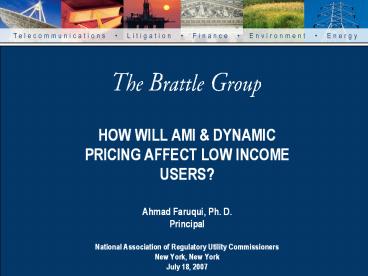HOW WILL AMI PowerPoint PPT Presentation
1 / 8
Title: HOW WILL AMI
1
HOW WILL AMI DYNAMIC PRICING AFFECT LOW INCOME
USERS?
- Ahmad Faruqui, Ph. D.
- Principal
- National Association of Regulatory Utility
Commissioners - New York, New York
- July 18, 2007
2
Reasons why it might hurt them
- They cant shift much load since they dont have
much load to begin with - Most dont have central or room air conditioning
equipment - They have dont the money to invest in enabling
technologies that facilitate peak clipping and
load shifting - They dont have the money to pay an additional
metering charge - AMI will be used to remotely disconnect them when
they fall behind in their payments - Ergo, they will be made worse off and should be
excluded from AMI and dynamic pricing
3
Reasons why it will help them
- Many low-income customers will benefit from
dynamic pricing since they have
flatter-than-average load profiles - Others will benefit because they have a strong
motivation to save money by curtailing peak load - Californias pricing experiment (SPP) provides
supporting evidence - In Track B, which focused on low income consumers
in San Francisco, consumers reduced peak load by
2.6 percent - In Track A, on a statewide basis, customers with
incomes below 40,000 curtailed peak load by 10.9
percent and those on the CARE rate by 2.9 percent - The average customer in California curtailed peak
load by 13 percent, the average customer in the
temperate climate zone by 7.6 percent - All together, 77 percent of all customers saved
money - Low-income users have also responded to RTP rates
in Chicago
4
How can we protect low-income users?
- Waive the AMI metering fee for all low-income
users - Make the AMI metering fee volumetric, which would
favor low users, many of whom would be low-income
users - Raise the low-income discount on the monthly bill
(in California, this is already 20 percent) - Credit them (and all other users) with a credit
for the hedging premium when they shift to
dynamic pricing - Monte Carlo simulations show that more than 95
percent of users would benefit if given a 3
percent hedging premium
5
With demand response, AMI and dynamic pricing
become attractive to over 95 of customers
6
Should we protect low income users?
- This is a major policy issue that should be
debated in every state - What is not a good idea is the notion of
excluding low-income users from AMI and dynamic
pricing - This Swiss cheese deployment will prevent the
full operational benefits of AMI being achieved - It will raise The Gap that has to be covered by
demand response and prevent its deployment - All other customers will be deprived of demand
response benefits that nationally speaking, could
be in the 35 billion range
7
Additional reading
- Brattle Group, The. The power of five percent.
Discussion paper. May 2007. - Brattle Group, The. Quantifying the benefit of
demand response for PJM, prepared for PJM
Interconnection LLC. and MADRI, January 2007 - Faruqui, Ahmad. Breaking out of the bubble how
dynamic pricing can mitigate rate shock, Public
Utilities Fortnightly, March 2007. - Federal Energy Regulatory Commission (FERC), The
US. Demand Response and Advanced Metering, Staff
Report, August 2006 - North American Electric Reliability Corporation
(NERC). 2006 Long-Term Reliability Assessment,
October 16, 2006. - Plexus Research, Inc., Deciding on Smart Meters,
Edison Electric Institute, September 2006.
8
Contact information
- Ahmad Faruqui, Ph. D.Principal
- The Brattle Group353 Sacramento Street, Suite
1140San Francisco, CA 94111Voice
415.217.1026Fax 415.217.1099Cell 925.408.0149
- Email Ahmad.Faruqui_at_Brattle.Com

